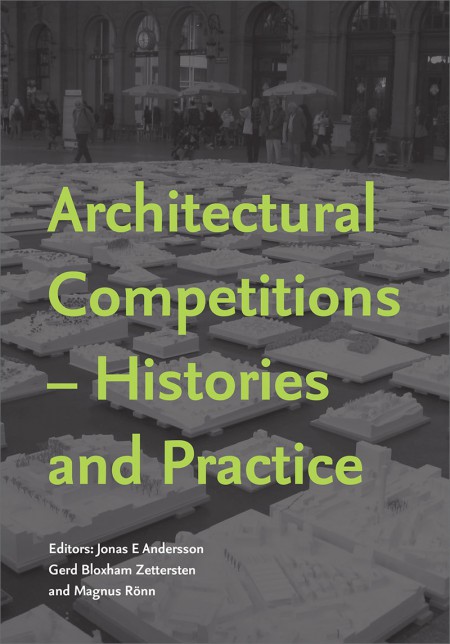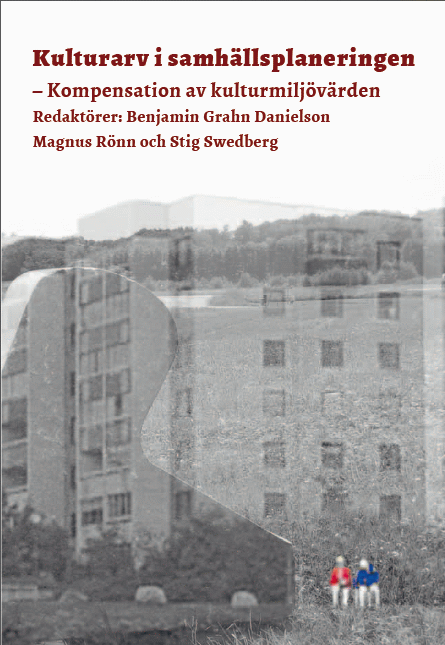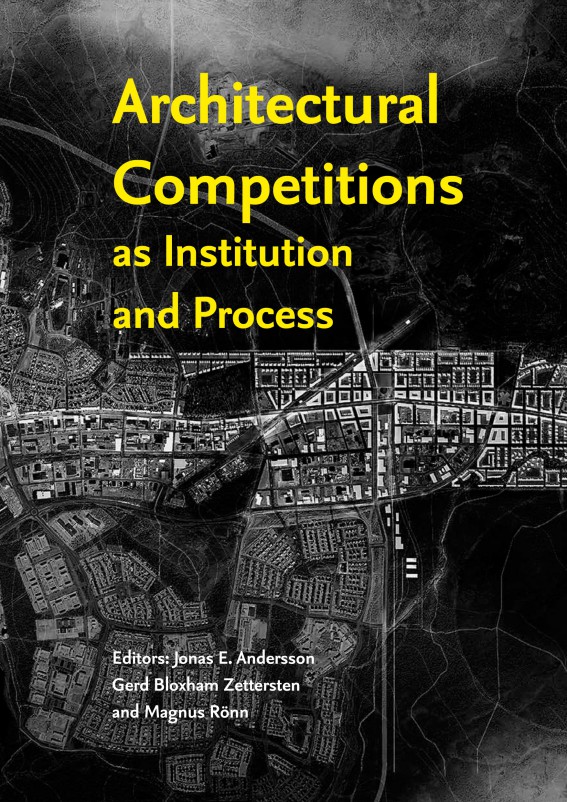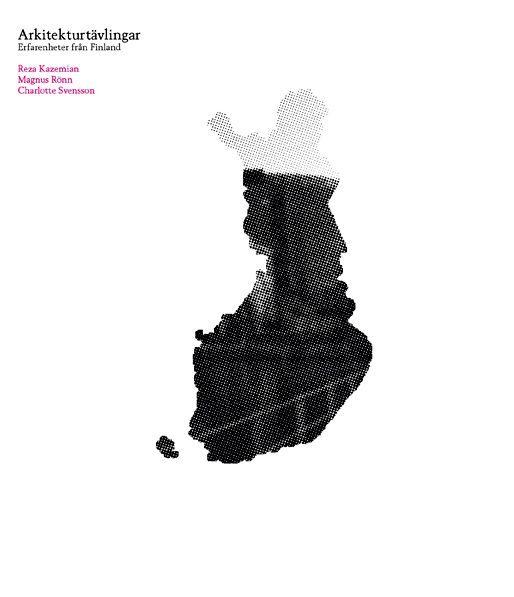Beskrivning
Editors: Magnus Rönn, Jonas E Andersson och Gerd Bloxham Zettersten
Additional writers: Maarit Kaipainen, Antigoni Katsakou, Judith Strong, Pedro Guilherme, João Rocha, Leentje Volker, Kristian Kreiner, Charlotte Svensson, Elisabeth Tostrup, Thomas Hoffmann-Kuhnt och Mats T Beckman
ISBN: 978-91-85249-16-9
© Rio Kulturkooperativ and KTH Architecture and the Built Environment 2013








NORDISK ARKITEKTURFORSKNING Nr 1-2014, Hennu Kjisik, Architect SAFA, Dr.Tech., professor Partner, Harris-Kjisik Architects and Planners, Helsinki Professor of Urban Design, Faculty of architecture, University of Oulu –
In Finland, sometime in the 1980s, a subject of debate came up in the
professional press which at the time seemed rather surprising. Some
colleagues, more academically inclined than the great majority, were
worried about the lack of research published by the architects as a
professional body. The reply from the hard-core practitioners was that
taking part in competitions was research in itself and that everyone
was doing it all the time. The academics disagreed, claiming that
competitions were simply an established part of professional practice,
a relatively pleasant way of procuring commissions, and practically the
only way to become famous.
Since then «practice-based research» or «research by design» have
gradually become accepted by the academic community as credible
scientific endeavours. The interpretivist research tradition in which the
understanding of certain actions, systems and arrangements comes
through a process of interpretation, also lends itself well to the pursuit
of design competitions. Thus this book constitutes a review of research
published about an activity that only recently, and even now not without
some protest, can also be classified as research.
In Finland we used to have preconceived ideas about how things work
in other countries, ideas that have often proven to be urban myths. For
example, we thought that the Swedes only used three categories in their
evaluation criteria: quite nice (ganska trevlig), nice (trevlig) and very
nice (väldigt trevlig). This made the system, if not totally flawed, at least
less analytical than our own, and also excessively dependent on typical
Swedish consensus policies. Maybe we were not completely wrong
since, at the end of this book, Charlotte Svensson stresses the need for
total unanimity among the jury members and concludes with: «In this
regard, the selection of a Pope in Rome provides similarities to how jury
members choose winners in architectural competitions in Sweden.»
The (almost non-existent) British competition system we found totally
unacceptable. One high profile dictator-judge decided the winner while
secretly worrying about what «the Prince» would think about his or her
decision. We used to admire the French for enforcing a competition on
anything larger than a dog kennel, even if our French colleagues told us
that the system did not really work, since the same people were always
invited to compete. We always knew and admired the fact that the Swiss
organised a lot of competitions, but on the other hand it seemed to be
just another feature of a country that holds almost daily referenda about
all possible aspects of life.
This book is useful from a variety of perspectives, but also in the way it
helps to at least modify these myths and stereotypes. It is interesting
to read, in the article by Antigoni Katsakou, that Switzerland may after
all not be such a «competition heaven», but the universal criticisms
that the same offices always get shortlisted are voiced there as well.
The «introverted character» of the Swiss architectural profession is
also emphasized. Foreign architects («all the usual suspects» included)
apparently rarely win first prize, but usually only lesser prizes. This article
also introduces some less familiar names from the younger generation
of Swiss architects. I shall follow with great interest the development of
the careers of, among others, Frei & Gysel and their Futurafrosch office,
whose work seems original and fascinating. This contribution to the
book is, however, somewhat marred by a lack of editing.
In Britain, the situation does not seem to have changed a lot. Judith
Strong’s article gives the impression that the quiet competition scene
is seen entirely as a procurement method, not as research or as a means
to generally «improving oneself,» not to mention being a natural part of
one’s professional pursuits. Strong’s choice of words is indicative of the
depressing situation in Britain. She, for example, cites the «abandoned»
Stockholm Library Competition, as one case used in England to argue
against the usefulness of competitions. In Finland we would see the
Stockholm case as an enormous body of interesting projects (great
subject for research!), which unfortunately has not led (so far) to
realisation. «Abandoned,» however, is hardly a word we would use in this
context.
Lentie Volker presents a fascinating story about what happened after
a fire annihilated one of the most famous architecture schools in the
world, the Bouwkunde in Delft. The multi-faceted competition process
is described and analyzed in great detail. Finally, when the reader starts
to become anxious about the outcome of the whole affair, the writer
concludes, «In this case the aim was to collect ideas and stimulate
debate, while in other competitions selecting a single design for a
building could be a main goal.» Thus the Dutch see the spending of
resources on competitions as valuable per se, and do not simply treat
them as an alternative procurement method, in contrast to the Brits.
According to Pedro Guilherme and Joao Rocha, for Eduardo Souto
de Moura «competitions seem to be the optimal place to innovate
and to deal with all that cannot be dealt with on a daily basis.» This
contribution to the book presents facts and figures about the more
than 50 competition entries that Souto de Moura has done in the last
three decades. The authors of this significant article conclude that
«competitions are either won or lost and even if Souto de Moura wins,
it does not mean that the project will be built.» Unfortunately, this
thoroughly researched contribution does not specify whether the listed
competitions have been open or limited, i.e., to what extent financial
compensation has been guaranteed. Knowing how reluctant the most
successful practices are to do any unpaid work nowadays, it would be
nice to know that Souto de Moura, a Pritzker prizewinner, is indeed an
exception.
Kristian Kreiner appears to be a prolific author on the subject at hand
and produces one of the most entertaining contributions to the book.
In his introduction he coins a satisfying phrase – «institutionalized
masquerading» – to describe the behaviour of the various actors in
these processes. By stating that this «masquerading favours creativity
over reputation and gives young and inexperienced architects a
chance for a breakthrough», he gives a simple but astute argument in
support of competitions. His analysis is to my mind occasionally slightly
overwrought. He claims, for instance, that for a competitor, a competition
«is never just another competition».
Kreiner’s very relevant discussion on the interpretation of competition
briefs is especially topical, since «unusually vague» briefs, such as the one
in his research case (the re-use of an old industrial building for a «large
Danish University») are becoming increasingly common everywhere. The
description of the way the jury reacted to the technically problematic
glazed southern façade in the winning entry sounds very familiar. It
shows that juries «masquerading» as objective bodies and staunch
advocates of sustainability often end up making decisions that are
perfectly understandable but difficult to justify.
Mats T. Beckmann, Jonas E. Andersson, Thomas Hoffmann-Kühnt,
Elisabeth Tostrup and Maarit Kaipainen provide contributions based
mainly on interesting case studies. Beckmann brings up another topical
concept, that of «parallel sketching,» when concluding his analysis of the
1934 Stockholm-Bromma 1934 case. He writes: «a reasonable conclusion
[…] is that the part of the overall planning process that was completed
by the four architects should preferably be termed parallel architects’
assignments.» Finnish colleagues have criticized the procurement
method Beckmann refers to as being against the best traditions of
real competitions. It is, however, also gaining ground in Finland. Our
office recently took part in one, and just like Paul Hedqvist’s proposal
at Bromma in 1934, ours was chosen. It felt like a competition, but
unfortunately it cannot be added to our list of competition successes.
Magnus Rönn, in his own contribution, deals with the subject of
prequalification, an essential subject in the present competitive
procurement discourse. Judith Strong and many of the other writers
also touch upon this subject. Rönn finds only a «handful» of studies
of prequalification, which is surprising considering its importance for
anyone running an office, and, in fact, for anyone concerned with the
quality of our built environment. Rönn comes to a conclusion that is easy
to agree with, namely that too often «prequalification is a conservative
force».
In the introduction to the book, Rönn and his editorial colleagues Jonas
E. Andersson and Gerd Bloxham Zettersten express surprise over the fact
that the first serious research on competitions did not appear before the
1990s, in spite of the organised competition institution already being
more than 150 years old. «Now,» they write, «there are some 15 academic
dissertations and a number of ongoing doctoral projects on the subject
in Canada and Europe.» The editors believe, and indeed the book proves,
that «the architectural competition is an interesting and rewarding
object for research.»
To conclude, I would like to suggest a subject for someone to study:
the two-stage international open competition, and more specifically,
its intermediate evaluation phase. Having been involved in this
competition genre both as a competitor and as a jury member, I find
that the evaluation of the first stage and the formulation of the written
instructions given to the finalists may play a totally decisive role in
determining the final success of a competition of this kind. There are
undoubtedly several fascinating cases to choose from. One could start
with the abovementioned Asplund Library extension competition in
Stockholm. Could it be that the «abandonment» had something to do
with the way the intermediate evaluations were formulated? Could it be
that they contributed to the fact that the top entries did not fulfil the
promise of the first stage? I have no idea, but I think someone should try
and find out.
Reviewed by Hennu Kjisik, Architect SAFA, Dr.Tech., professor
Partner, Harris-Kjisik Architects and Planners, Helsinki
Professor of Urban Design, Faculty of architecture, University of Oulu